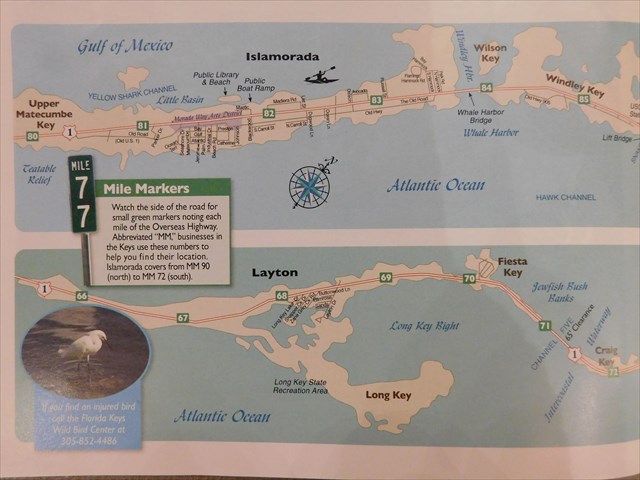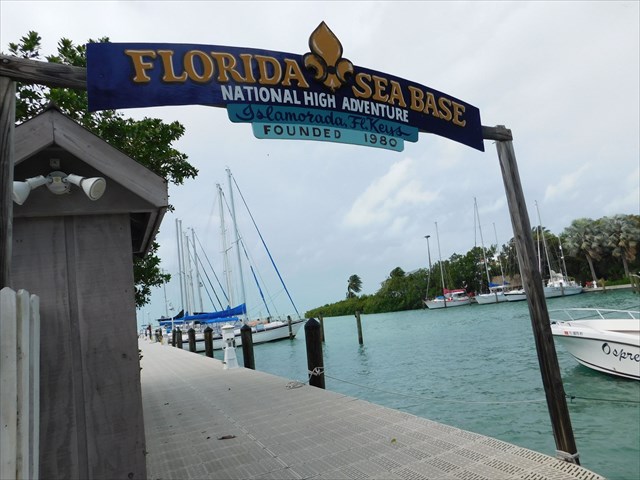GEOLOGY OF SEA BASE, FL:
This EarthCache focuses on the geology, created by marine life, of the mid-section of the Florida Keys in Islamorada. The upper or northern Keys are composed of sediments that formed Key Largo Limestone, atop a solid rock foundation derived from ancient coral reefs. The lower or southern Keys originated from huge non-sedimentary sandy and Miami Oolite deposits of calcium carbonate shoals crossed with numerous channels. Both sections derive from the high sea levels of the last interglacial. As the Keys protruded out of the vast sea, various waterways fell into formation into, around, and along the islands. Learning the terms for these geological waterways is one of your objectives.
During the Pleistocene Epoch (from 2.6 million years ago), the sea level fluctuated repeatedly. Evidence of this can be seen today in thin bands of fine-grained accumulated fossiled sediments, alternating with thick bands of cross-bedded sediments. Sea level rose, as much as 100 feet higher than today, as ice sheets retreated. Sea level fell, as ice sheets advanced. About 125,000 to 100,000 years ago during the Sangaman interglacial period, the climate cycle began cooling with the polar ice caps growing. This caused the high ocean levels to start dropping. The ancient living coral reefs that thrived for millions of years started dying with the lowered sea level and eventual exposure of the resulting Keys. Shoreline expanded with more land mass exposed. Drop could have been 300 to 450 feet. About 20,000 years ago, ocean levels again fell. Then about 6,000 years ago, when sea levels rose again following the Wisconsin Ice Age, outer reefs became covered. Today, sea water is noted to be on the rise.
Sea level thus constantly changes with fluctuating cooling and warming conditions. Peaks occurred at about 120,000, 80,000, and 30,000 years ago. One agency recording sea levels for decades is the Navy. The average over 8,000 years had been 3.5 inches increase over 100 years. Three decades ago, it was 15 inches over 100 years. The rising sea level is said to threaten to submerge the Keys archipelago as early as in the next century.
While most focus on the Keys concentrates on their creation from ancient coral reefs and sand bars, the water alongside, surrounding, and protruding into the islands has significance as well. This focus on water inlets may be interesting to consider as sea levels rise further.

The Geographic Names Information System (GNIS) developed by the United States Geological Society (USGS) (Charttiff.com accessed Jan. 3, 2016) and Nature Definitions (thealmightyguru.com accessed Jan 3, 2016) provide these definitions below for the various types of named waterways in the Islamorada vicinity. Listed beneath each of the eight types of waterways are examples of actual water paths that may be viewed on the maps.
BASIN - natural depression or relatively low area enclosed by higher land
e.g., Little Basin
BAY - indentation of a coastline (inlet) or shoreline enclosing a part of a body of water
e.g., Florida Bay
BIGHT - an inlet bend in a coast forming an open bay
e.g., Long Key Bight, Matecumbe Blight
COVE - a small sheltered inlet
e.g., Caloosa Cove
CHANNEL - linear deep part (inlet) of a body of water through which the main volume of water flows and is frequently used as a route for watercraft
e.g., Yellow Shark Channel, Channel Five, Channel One, Hawk Channel, Indian Key Channel, Teatable Key Channel, Lignumvitae Channel
CREEK - a medium natural waterway, larger than a stream
e.g., Snake Creek, Tavernier Creek
HARBOR - shelter area (inlet) of water where ships or other watercraft can anchor or dock
e.g., Windley Harbor, Whale Harbor, Matecumbe Harbor
WATERWAY - any narrow pathway of water that is constantly moving
e.g., Intercoastal Waterway

EARTHCACHE LOGGING TASKS:
To receive credit for this EarthCache, you must complete these Logging Tasks.
1.Geologically define 3 of these 8 terms: basin, bay, bight, channel, cove, creek, harbor, waterway. Name one example in the Islamorada region for each of the 3 terms you select.
2. Go to one of the two waypoints for the shoreline coordinates: One looks upon Matecumbe Harbor and one looks upon Caloosa Cove. What do you see in the harbor, or do not see in the cove, that distinguishes the two different waterways (read definitions and see hint)? Describe the current water level by referring to one geological structure or man-made-device against which one show changes in water rising or falling. Give the time you are there.
3. Name one agency that is measuring the sea level. At the current rate of rising sea level, calculate as best you can how long would it be until the rising water reached the mid-point of the yellow objects at the cove coordinates, or covered completely the rocky shore at the harbor coordinates.
It is not necessary for you to seek outside sources to complete these tasks; all information can be found here, or at the physical site.
Email your answers to me, separately from your log, which you may post right away as a "Find". If there is a problem, or if you have a question, then I will write back to you.
Enjoy continuing to learn about geology in your country and in the world. Plus, take time to read about academic research that has been done to protect our geological environment. And think about and share innovative ideas to promote and practice sustainability for our planet Earth.
EARTHCACHE RULES:
When participating in EarthCache, you, the geocacher, agree to adhere to the principles of geocaching, Leave No Trace, and Outdoor Ethics. You also agree that the site must not be damaged, and that the fragile ecosystems must be respected. EarthCache visitors collect memories, not samples, from these virtual sites. No physical caches or other items are to be left at the EarthCache site. Learn about your Earth’s geology, protect it, and have fun.
MINIMAL ECOLOGICAL IMPACT ON THE KEYS:
This EarthCache not only celebrates the geological splendor of this Florida region, but reminds geocachers of the commitments of Islamorada and the Sea Base and other groups to preserve and sustain these fragile resources of our Earth.
The Boy Scouts of America (BSA) FLORIDA HIGH ADVENTURE SEA BASE in Islamorada, FL, being situated with one body of water, Matecumbe Harbor, to its West, and a second body of water, the Caloosa Cove, to its South, served as an ideal site for this EarthCache. The two very different bodies of water serve as the waypoints at which to experience and learn geological lessons. You as EarthCacher may reach 73800 Overseas Highway and the two nearby seashore coordinates 1) by driving, or 2) by walking on the public pedestrian walkway that traverses much of the length of the key, or 3) by biking on the public bikeway that also covers much of the length of the key. The three sets of coordinates are all within 8 minutes by walking of each other. The primary coordinates are located just off Highway 1 at the entrance to Sea Base where one may see the sign on the coral rock formation. Please do not enter the private youth facility, or the private residences nearby. The cross street on Highway 1 is Toll Gate Boulevard.

As there are four locations to Sea Base, there are many other opportunities to explore the geological wonders of the region. Two are on the beautiful 220-miles Florida Keys consisting of about 882 charted islands. The first operates on Lower Matecumbe Key in Islamorada at Mile Marker 73.8, and the second operates on Summerland Key at Mile Marker 23.8 at the Brinton Environmental Center. The third location is Marsh Harbour, Great Abaco Island, Bahamas. The fourth location is new and in the Virgin Islands. All locations protect magnificent waterfronts and shore reefs. Just as the BSA has a strong, century-old foundation in its Scout Oath and Scout Law, this Florida gateway has a strong, millions-years-old geological foundation.
EarthCaches also celebrate three other high adventure bases:
PHILMONT SCOUT RANCH in New Mexico (GC56VYB)
SUMMIT BECHTEL RESERVE in West Virginia (GC4KE2X)
NORTHERN TIER in Minnesota (GC6Z77E)
Try to find time to visit these EarthCaches to experience a bit of how high adventure expeditions affect youth and geocachers alike. Outdoor challenges shape youth and teach them about themselves. High adventure EarthCaches unveil geological magnificence and teach you about your Earth. Both activities emphasize the sustainability of our fragile environment.
SOURCES:
Coastal Issues in the Florida Keys, http://cee514coastalanalysisfloridakeys.weebly.com/geology.htm (accessed 11/29/2015).
Dry Tortugas National Park Geologic Resources. http: www.nps.gov/drto/learn/nature/geology.htn (accessed 11/29/2015).
Florida Keys National Marine Sanctuary, "The Florida Keys are made of limestone." http://floridakeys.noaa.gov/ocean/limestone.htm (accessed 11/29/2015).
Geotimes (Aug 2008). "The Florida Keys: From Key Largo to Key West." http://www.geotimes.org/aug08/article.html?id=Travels0808.htm (accessed 11/29/2015).
Haley, Robert B., et. al., Geology and Hydrology of the Florida Keys, USGS, South Florida Information Access (SOFIA).
http://sofia.usgs.gov/publications/papers/keys_geohydro/index.html(accessed 11/29/2015). Figure 5-1.
Islamorada Chamber of Commerce brochure. Islamoradachamber.com/brochure2014/06-map.pdf (accessed 11/29/2015).
Wilkinson, Jerry. Keys Geology. http://keyshistory.org/keysgeology.html (accessed 11/29/2015).